Samsung Galaxy Book 2 vs. Microsoft Surface Pro 6: Face-off!
With the Galaxy Book 2, Samsung goes toe to toe against Microsoft for the title of best detachable 2-in-1. The Samsung tablet's secret weapon is a Snapdragon 850 processor, which promises 20 hours of battery life, and Gigabit LTE connectivity. But the Galaxy Book 2 faces a capable foe in the Surface Pro 6, an Intel-powered detachable that earned a 4.5-star rating and our Editor's Choice award for its quick performance, gorgeous display and long battery life.
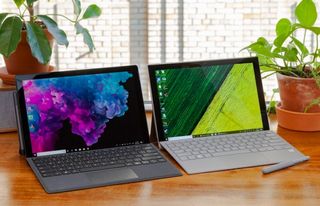
Can the Samsung Galaxy Book 2 pull off the upset, or will the Surface Pro continue its reign as our favorite detachable tablet on the market? Let's find out.
Samsung Galaxy Book 2 vs. Microsoft Surface Pro 6: Specs Compared
| Row 0 - Cell 0 | Samsung Galaxy Book 2 | Microsoft Surface Pro 6 |
| Price (Starting/as configured) | $999 | $899 ($1,429) |
| Colors | Silver | Platinum, Black, Cobalt Blue, Burgundy |
| Display | 12-inch, 2160 x 1440 | 12.3-inch, 2736 x 1824-pixel |
| CPU | Qualcomm Snapdragon 850 | Intel 8th Gen Core i5, i7 |
| RAM | 4GB | 8GB, 16GB |
| SSD | 128GB | 256GB, 512GB, 1TB, 2TB |
| Key Travel | 1.7mm | 1.3mm (Type Cover) |
| Ports | 2 USB Type-C port, microSD, headphone | USB 3.0, Mini DisplayPort, Surface Connect port, microSD, headphone |
| Webcam | 5MP (8MP rear) | HD (720p) |
| Size | 11.3 x 7.9 x 0.3 inches | 11.5 x 7.9 x 0.3 inches |
| Geekbench 4.1 | 3,575 (32-bit) | 13,761 |
| Battery Life (hrs:mins) | 10:41 | 9:20 |
| Weight | 1.8 pounds (2.5 pounds with keyboard) | 1.7 pounds (2.4 pounds with keyboard) |
Design
These two sleek detachable tablets have very similar designs. Like the Surface Pro 6, the Galaxy Book 2 is a stylish aluminum slate with a smooth, silver back panel and a rotating kickstand that props the tablet into laptop or studio mode. From the front, the Surface and Galaxy devices look identical, each with thick, ugly display bezels.

An advantage of the Surface Pro 6 over the Galaxy Book 2 comes in the various color options you can choose. The tablet is available in Black and Silver, while the Type Cover keyboard accessory comes in Coral Blue, Burgundy, Black and Platinum. The Galaxy Book 2 is limited to a silver chassis and a gray keyboard.
There are a few minor annoyances with the Galaxy Book 2's design that aren't an issue with the Surface Pro 6. Namely, the slim kickstand makes the tablet uncomfortable to use on your laptop and the small indents for popping the hinge off the back panel are difficult to grip.
Stay in the know with Laptop Mag
Get our in-depth reviews, helpful tips, great deals, and the biggest news stories delivered to your inbox.
Both tablets are designed for users who want a portable computer that can easily slip into a backpack or be carried around the house. To that end, the Galaxy Book 2 and Surface Pro 6 are exceptionally slim and lightweight. At 11.3 x 7.9 x 0.3 inches, the Galaxy Book has almost the same dimensions as the Surface Pro (11.5 x 7.9 x 0.3 inches). And at 1.8 pounds (2.5 pounds with the keyboard), the Samsung detachable is a mere 0.1 pounds heavier than the Surface (1.7 pounds, 2.4 pounds with the keyboard).
Winner: Surface Pro 6
Ports
The two USB-C ports on the right side of the Galaxy Book 2 give it an advantage over the Surface Pro 6, which inexplicably omits the crucial charging port and opts for a proprietary Surface Connect port instead. On the other hand, the Galaxy Book 2 lacks a USB Type-A port, making the Surface Pro 6 a better choice if you want to connect peripherals, like mice or keyboards.
MORE: Ports Guide
Apart from their USB ports, the Surface Laptop and Galaxy Book 2 each house a microSD card slot and a headphone jack.
Winner: Draw
Display
The Galaxy Book 2 and Surface Pro 6 have some of the best displays we've seen on any tablet or laptop. However, the OLED display technology employed by Samsung provides deeper black levels, higher contrasts and better viewing angles when compared to LED panels.
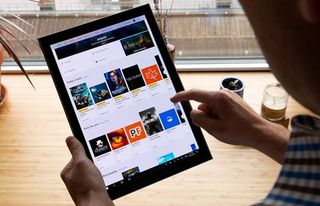
The Galaxy Book 2's 12-inch, 2160 x 1440-pixel display is very sharp, but the Surface Pro's 12.3-inch, 2736 x 1824 display has an even greater pixels-per-inch density, making it marginally more detailed.
When it comes to color, few displays can keep up with the Galaxy Book 2's exceptionally vibrant Super AMOLED panel, which covers 200 percent of the sRGB gamut. The Surface Pro 6's screen re-creates 136 percent of the color spectrum — an excellent result but well short of the Galaxy Book 2's mark. Both tablets are more colorful than the average premium laptop (116 percent).
The Surface Pro 6 fights back with a maximum display brightness of 408 nits. The Galaxy Book 2 peaked at 328 nits, which beats the premium laptop average (311 nits), though Samsung's tablet is much dimmer than the Surface Pro 6.
Winner: Galaxy Book 2
Keyboard
Detachables aren't known for having good keyboards, but both the Galaxy Book 2 and Surface Pro 6 surprised us in this regard.

The Surface Pro 6's Type Cover has 1.3 millimeters of key travel, which is just short of our 1.5mm preference but still good for a detachable. The keys feel cushy, and we had no problems hitting our typical words-per-minute average on the 10fastfingers.com typing test.
The Galaxy Book 2 has one of the most responsive keyboards I've used on a detachable, with a key travel of 1.7mm. Coupled with an ideal actuation force of 70 grams, the Galaxy Book 2's snappy, backlit keyboard proves that you can get a comparable or even better typing experience from a detachable vs. a traditional clamshell laptop.
MORE: Best and Worst Laptop Brands
On the Surface Pro 6, I scored 114 words per minute with a 91 percent accuracy rate on the 10fastfingers.com typing test. With a score of 119 words per minute and a 9 percent error rate, I typed faster on the Galaxy Book 2's keyboard with the same accuracy score. My typical typing test results are 109 wpm at 95 percent accuracy.
Winner: Galaxy Book 2
Performance
Armed with Qualcomm's first made-for-PC processor, the Galaxy Book 2 is one of the fastest ARM-based laptops we've tested, but it still lags far behind its Intel-equipped competitors. Actually, the rift in performance between the Galaxy Book 2 and Surface Pro 6 is shocking.
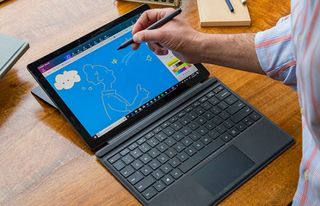
The Galaxy Book scored a measly 3,545 on the Geekbench 4 synthetic benchmark test, which gauges overall performance. Powered by an Intel Core i5-8250U CPU, the Surface Pro 6 scored an excellent 13,025 on the same test.
The Galaxy Book 2 lagged far behind on our Excel Macro Test, matching 65,000 names with their corresponding addresses in 2 minutes and 18 seconds. The Surface Pro 6 completed the task in almost half that time, at 1 minute and 12 seconds.
We saw similar results on the HandBrake video-editing test, which involves converting a 4K video into 1080p resolution. The Surface Pro 6 needed 23 minutes and 22 seconds to complete the challenge, while the Galaxy Book 2 took 39 minutes and 49 seconds.
Winner: Surface Pro 6
Graphics
With an Intel UHD 620 GPU, the Surface Pro 6 provides significantly better graphics performance than the Galaxy Book 2 and its Snapdragon 850 SoC. Microsoft's detachable scored a 73,697 on the 3DMark Ice Storm Unlimited benchmark, more than double the Galaxy Book 2's 30,420.

The synthetic benchmark translated into real-world performance, with the Surface Pro 6 playing the racing game Dirt 3 at 81 frames per second. At 24 fps, the Galaxy Book 2 lost handily to the Surface Pro 6, failing to reach our 30-fps playability threshold.
Winner: Surface Pro 6
Battery Life
ARM-based chips promise epic battery life, but those gains aren't as groundbreaking as I had hoped.
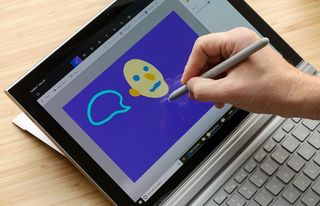
The Galaxy Book 2 stayed powered for 10 hours and 41 minutes on the Laptop Mag Battery Test (continuous web surfing at 150 nits of brightness), which is great, but well short of Samsung's ambitious 20-hour estimates. Yes, the time crushes the premium laptop average of 8:12, but the Surface Pro 6 put in its own respectable time of 9 hours and 20 minutes.
Winner: Galaxy Book 2
Value and Configurations
The Galaxy Book 2 comes in one configuration at one price. For $999, the 12-inch laptop comes with a Snapdragon 850 CPU, 4GB of RAM and a 128GB SSD. Samsung wins points for including the keyboard and S Pen for that price, something Microsoft won't budge on. But despite the lower price, the Surface Pro 6 is a better value when you consider per-dollar performance.
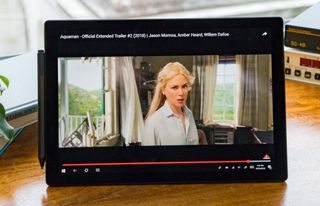
For $899, the base Surface Pro comes equipped with an Intel Core i5 CPU, 8GB of RAM and a 128GB SSD. The price jumps to $1,129 once you add the Type Cover keyboard and Surface Pen.
Opting for the Core i7 CPU and doubling storage to 256GB increases the price of the Surface Pro to $1,499 without accessories. A $2,299 decked-out version comes with a Core i7, 16GB of RAM and a 1TB SSD.
Winner: Surface Pro 6
Overall Winner: Surface Pro 6
| Row 0 - Cell 0 | Samsung Galaxy Book 2 | Microsoft Surface Pro 6 |
| Design (10) | 7 | 9 |
| Ports (10) | 5 | 5 |
| Display (15) | 14 | 12 |
| Keyboard/Touchpad (10) | 8 | 7 |
| Performance (20) | 8 | 16 |
| Battery Life (20) | 18 | 16 |
| Value (10) | 4 | 6 |
| Overall (100) | 64 | 71 |
The Surface Pro 6 is the better overall tablet, largely because it outperforms the Galaxy Book 2 by a wide margin. The low-power Snapdragon 850 chip promised to offset its poor performance with record-breaking endurance. But we found that the Galaxy Book 2's battery life isn't significantly better than that of the longest-lasting Intel-powered machines, like the Surface Pro.
That's not to say that the Galaxy Book 2 doesn't have its own advantages over the Surface Pro. The included keyboard is snappy and has excellent key travel, and Samsung's reliably gorgeous Super AMOLED display is wonderfully vibrant.
In the end, these two detachable tablets have more similarities than differences. They both have comfortable detachable keyboards, premium and practical designs, and beautiful displays. However, speed and stability should be the main priority when purchasing any device; therefore, the Surface Pro 6 wins this contest, hands down.
Credit: Laptop Mag
Phillip Tracy is the assistant managing editor at Laptop Mag where he reviews laptops, phones and other gadgets while covering the latest industry news. After graduating with a journalism degree from the University of Texas at Austin, Phillip became a tech reporter at the Daily Dot. There, he wrote reviews for a range of gadgets and covered everything from social media trends to cybersecurity. Prior to that, he wrote for RCR Wireless News covering 5G and IoT. When he's not tinkering with devices, you can find Phillip playing video games, reading, traveling or watching soccer.

